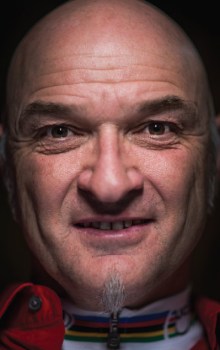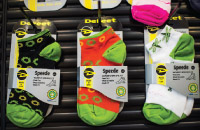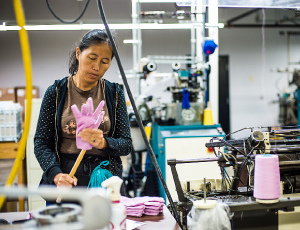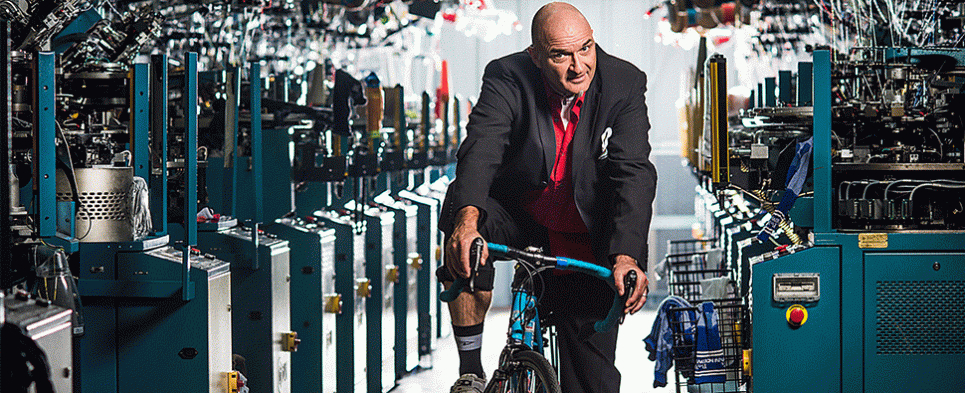Victory of DeFeet
“That is etched in my mind,” Shane Cooper says of his company’s first sale back in 1992. The musician-turned-cyclist-turned-owner of DeFeet International, maker of competitive cycling socks, had contacted Cannondale looking to sell the bicycle brand customized socks emblazoned with its famous logo. His ambitions were fairly modest: Make enough cash “peddling” socks to fund his amateur racing career.
Today, Cooper says, the cycling apparel industry is like NASCAR, with companies eager to stamp their logo on whatever they can coax onto a racer. That wasn’t the case when he called Cannondale, unaware he was about to tap into a wide-open market—so long as he didn’t alienate his early customers.
“I remember trying to tell the lady who I was on the phone with, who was a designer for them, that they needed to take this logo the way that I thought it should be, because that was the best way,” he says. “Finally she stopped me and she said, ‘Shane, do you realize that I’m the customer?’ And I backed up and I said, ‘Yes. What would you like?’”
After Cannondale, Cooper picked up accounts like money strewn across the ground. “It was just a floodgate. And for nine years it was that way—it was grow, grow, grow. It was 50 percent growth a year, paying off machinery as soon as we bought it, paying off the building as soon as we made an addition. I got kind of cocky there for a while. Every product we came out with became an instant success. We didn’t have any failure until we burned down in 2001.”
Yes, burned down. “Had it not been such a strong product, DeFeet would not have survived the fire,” says Lynn Moretz, vice president for international distribution. It’s a story that rivals those of the Old Testament: After its rise from the ashes, DeFeet would overcome a flood, a $250,000 theft and, scariest of all, an IRS audit to take home a 2012 Presidential “E” Award for Exports.

Meshing of Talents
DeFeet represented the intersection of Cooper’s interests and talents, with the first avenue paved back in Stapleford, England, where his father cultivated a career as a knitting machinery distributor, mechanic and salesman. Working his way up from an apprenticeship, “Dad saw America as the land of opportunity,” says Cooper. When Shane was four years old, his father brought him to America and took over distribution for Bentley knitting machines during a time when the company’s workforce dropped from 5,000 to 90 employees.
In time his father came to run a hosiery mill in North Carolina, and it was here that Shane took his job as a “yarn boy,” leaving his post as “bag technician” of the local grocery store. “I rode my bicycle to work, so I always had the bike in my life and didn’t know it,” Cooper says. He spent four years at the hosiery mill, mentored by Harvey Franklin, an employee of his father’s, and became a trained mechanic “by mistake.”
Cooper was dyslexic and struggled in the classroom. After high school he joined a band and toured the southeastern college circuit. He kept his bike in the equipment truck and would “ride with the frat boys” in his spare time. As the dream of rock stardom waned, the bicycle took center stage. He was an amateur racer and told his father he wanted to open a bike shop, to which his father responded with wise advice: Why not work for a bike shop for a while, see how you like it? The younger Cooper complied and through the bike shop he met his wife, a triathlete. When his father was diagnosed with colon cancer, Cooper left to manage his business, ultimately hatching the idea to use his hosiery experience—and a spare knitting machine in his father’s 5,000-square-foot facility—to engineer cycling socks in a fashion the world had never seen.
It’s interesting to wonder whether dyslexia played a role in the genius of what came next.
“The way we make our socks is completely backwards from what most people make,” Cooper says. “And it’s because the material at the time that became available was CoolMax, and it was space-age material. The way you normally make a sock is you put the sock material to the outside and the rebar-nylon to the inside. And I thought, ‘That’s ridiculous!’ If this material is moisture wicking it should be next to the skin—put the nylon to the outside, CoolMax to the inside. The nylon acts like rebar on the outside, so it creates a durable sock.”
The simple concept hadn’t occurred to anyone else, and if it had, they still would have had to deal with the difficulties of actually manufacturing it. “We had to re-engineer our machines; we had to retrain our employees to tie yarn on backwards, and that gave us a unique advantage 20 years ago.” That unique advantage coupled with a mastery of the difficult process of tediously knitting logos into each sock afforded an incredible and uninterrupted nine-year boon of 50 percent year-over-year growth from 1992 to 2001.
“My father used to say ‘Life’s a roller coaster, isn’t it?’ It certainly is,” Cooper laughs. “If you like uphills there’s downhills coming and if you like downhills there’s uphills coming. That’s the way this business was. For nine years I was enjoying the ride, and in year 10 all hell broke loose.”
Year 10
Through nine years Cooper could do no wrong. After its first year in business, DeFeet socks were on the feet of the world’s top cyclists, including his hero, champion cyclist Greg LeMond. In 1996, a Belgian distributor met Cooper at Interbike, an annual cycling trade show in Las Vegas, Nevada, and partnered with Cooper to make DeFeet an internationally distributed brand. The U.K. followed, then Australia. After five years, Cooper had quite a lot to balance.
Through an employee, Cooper was introduced to Lynn Moretz, an off-and-on teacher of international business at Central Piedmont Community College in Charlotte, North Carolina, who had previously won an “E” Award for another sock maker. Moretz was a man with a plan, a professional who had been there before, knew what to look for and how to take an international program into overdrive.
 “DeFeet was so good, such high quality, functioned so well and lasted so well, that word of mouth spread through the very elite categories of cycling,” says Moretz. “Greg LeMond and other pro cyclists just basically spread the word amongst themselves. It was just amazing to me.” As he sat down with Cooper to assess exporting prospects, Moretz was shocked by the company’s financials. He saw that DeFeet had financed itself from internal sales growth and was even more impressed that it done so without advertising. Says Moretz: “I saw nothing but opportunity.”
“DeFeet was so good, such high quality, functioned so well and lasted so well, that word of mouth spread through the very elite categories of cycling,” says Moretz. “Greg LeMond and other pro cyclists just basically spread the word amongst themselves. It was just amazing to me.” As he sat down with Cooper to assess exporting prospects, Moretz was shocked by the company’s financials. He saw that DeFeet had financed itself from internal sales growth and was even more impressed that it done so without advertising. Says Moretz: “I saw nothing but opportunity.”
Moretz was to take over the international program immediately. Then Cooper’s phone rang at 6 a.m. on a Saturday morning, alerting him to a fire at his facility. Any disbelief would be understandable; one week before—6 a.m. on a Saturday—another call signaled that the facility’s burglar alarm had been triggered. Cooper arrived to find a couple doves fluttering around and ended all threats by bravely shooing the savages out. But this Saturday wouldn’t be so easy.
“As I drove up the road to get to the facility, I saw smoke probably about a half mile away, and I thought, ‘Oh my, God,’” Cooper says. “That was when things changed.”
DeFeet had done some expanding since Cooper began knitting socks on a single machine in his dad’s 5,000-square-foot facility. The company expanded to 15,000 and again to 50,000 square feet, adding an unattached wing that, luckily, housed several knitting machines kept safe from the fire. It was all Cooper needed to begin staging a comeback.
The Phoenix
What do you do when nine years of hard work and off-the-charts success goes up in smoke? “I didn’t even think about folding up,” Cooper says. “Don’t get me wrong, I broke down and cried like a baby for five minutes, and as soon as I stopped crying I just started fighting.”
Cooper hit the road, seeing clients face-to-face, shaking hands and giving each a gift bag with specialized socks featuring a phoenix, a card and a promise that DeFeet would be back. He was on the road for months at a time making up to six stops per day.
Before the fire, DeFeet had ordered 10 new knitting machines from Italy. They were destroyed in the fire, just ahead of the insurance agent’s visit to reassess the company’s property and add the machines to the policy. DeFeet was out $500,000 in machinery.
Meanwhile, another insurance battle was taking place in court over what DeFeet would be owed for its business loss insurance. After nine years of 50 percent year-over-year growth, the insurance company offered what most would regard as a punchline. “They came to the table and said, ‘We’ll give you three percent on what you earned last year.’ I said no way. It took us three years and we settled for 33 percent.”
The settlement reached high six figures and—as if DeFeet wasn’t having enough fun already—triggered an IRS audit the next year. Luckily, it was easier to survive. “We passed it within like one day,” Cooper says. “They got out here and saw what had happened and just kinda shrugged their shoulders and said, ‘Sorry.’”
Back on Track
DeFeet clawed its way back in the ensuing years and by 2003 it was time for Cooper and Moretz to pick up where they left off. Moretz came equipped with a plan.
“The strategy basically was to use importer-distributors, as opposed to working directly with retailers,” says Moretz. “If you work directly with retailers, it would be so difficult because there typically are so many of them. Making small shipments, it’s not economic. A distributor, on the other hand, can take goods in much larger quantities, often in sea container loads. The transportation cost per unit is much lower.” Moretz told Cooper he believed DeFeet could add 20 to 25 percent in sales by expanding overseas without cutting into the existing business. “And it has turned out that way,” Moretz says.
 But the universe wasn’t through testing Cooper. DeFeet was flooded the next year when a retaining wall behind the building gave way in a heavy rain. “The mud from the hill clogged the drainpipe and the water had nowhere to go,” Cooper says. About four or five inches of muddy water seeped into the building. “We were very lucky to catch it as it was happening. We reacted very quickly and saved our company from what could have been a huge disaster,” Cooper recalls. He rebuilt the hill and drain pipes and recovered from about $25,000 in damages.
But the universe wasn’t through testing Cooper. DeFeet was flooded the next year when a retaining wall behind the building gave way in a heavy rain. “The mud from the hill clogged the drainpipe and the water had nowhere to go,” Cooper says. About four or five inches of muddy water seeped into the building. “We were very lucky to catch it as it was happening. We reacted very quickly and saved our company from what could have been a huge disaster,” Cooper recalls. He rebuilt the hill and drain pipes and recovered from about $25,000 in damages.
In 2007, an employee would steal a quarter of a million dollars in merchandise—20 dozen pairs at a time—and sold to truckers along I-95 for a dollar per pair. Two years later, an accomplice blew the whistle saying, “God told me to come clean,” admitting to storing the stolen goods in his empty warehouse. DeFeet is still getting subpoenas and police arrested the former employee, but it has not yet gone to trial. Twenty-four thousand pairs of socks had been lost in the heist for a total retail value of $250,000. Cooper’s reaction via email: “On the bright side, the truck drivers love the socks.”
Award-Winning Shipper
With Moretz’s exporting plan under way, he persisted, methodically choosing international distributors that led to his many successes. He immediately recognized that DeFeet’s partners in Benelux (Belgium, Netherlands and Luxemburg) and Australia were not producing at a satisfactory level and replaced them. How did he see it coming? “Basically, it’s numbers,” he says. “For example, they may buy too heavily to start with and everything looks great, but then you go six, seven, eight months and there’s no purchasing.”
Moretz says it’s important to avoid being seen as too impatient with your international distributors and to respect the investment made on their end by giving the company ample time to succeed. “I feel that it’s only fair to give them two, two-and-a-half years, because they have invested, and it’s never a surprise. I have never terminated any distributor other than amicably.”
The pattern for developing successful distributors seems simple: “Monitor carefully, set goals and help them build their business. That’s what we do,” Moretz advises. He looks for a particular type of company: “Ideally, someone who’s been in business for at least several years that has excellent quality product lines that are complementary. For example, a good, strong bicycle shoe line, or other bikes or bike parts. DeFeet is a top-notch product in its category, and I want it to be associated with other such products.”

Once a distributor is in place, DeFeet typically will use a freight-forwarder preferred by the importer. “If they don’t [have a preferred freight-forwarder], we will get quotes for two or three and let them make a choice.” Of the 36 countries DeFeet ships to, only two markets require sea containers—Japan and the U.K.—and the company typically goes through the port at Charleston, South Carolina, its nearest major port. They use trucks to get to their other top market, Canada. Moretz says the company often relies on D.B. Schenker to move its goods.
For every other market—and even for Canada, where DeFeet has both a distributor and a direct relationship with Mountain Equipment Cooperative, a large retailer supplied via truck—the company ships smaller boxes through UPS, DHL, FedEx or even USPS. “They tend to be the least expensive,” says Moretz. “And it has worked well going to South Africa. However in Scandinavia, particularly Norway, we’ve had some delivery problems.”
How DeFeet Snatched Victory
By 2008, DeFeet had finally clawed its way back to profitability, due in no small measure to the strength of its export program, which was adding more than 20 percent to its bottom line. The popularity of the brand, however, is a result of what Cooper calls “Punk Marketing.” In the same way punk music has allowed artists to make music without being necessarily skilled musicians, Punk Marketing is a method of generating great interest in a product without a formal marketing degree.
“If I go to a bicycling event and I have my iPhone, I can take a movie, I can interview somebody, I can take a picture and I can send that right back to my company and we can Facebook it, Twitter it, use it on our website, and all the sudden you have a brand-new, dynamic from of marketing. Advertising in the palm of your hand,” Cooper calls it. “And that, to me, is giving the tools to an untrained musician, if you will. I don’t study marketing, I study my market and I understand it.”
In many ways this represents the definitive Shane Cooper: Incredibly adaptable and with the honesty to recognize his own shortcomings, measure them and course correct. For a man who willingly characterizes his former self as cocky, he demonstrates real humility. It comes through in a simple admission of failure about a man he holds dear—Harvey Franklin, the mentor assigned to him by his father back in Cooper’s “yarn boy” days. Franklin came to work at DeFeet during its rapid ascent, a skilled engineer capable of making Cooper’s strange sock visions a tangible reality. After the fire, however, a management team swept Franklin out as the company scrambled to stay afloat. Cooper lost sight.
“My father put me with him to learn work ethic. And in recent conversations with this man, he told me that and it brought a tear to my eye that my father thought that much of this guy and then I let him go. I didn’t take care of him when I should have. I should have led better,” Cooper says, and for the first time in a conversation spanning nearly two hours his voice drifts off for a moment, strained.
Only to come back full force: “When does this go to print?”
October.
“Well, hopefully I’ll have him back by then!”





Thank you Mr.COOPER . I’M glad you got my brother back on your team at Deffeet. I know he will give you his 100%. Hope to meet you one day you sound like a great person. GO DEFEET